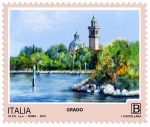POSTE ITALIANE 18^ Emissione del 06 Luglio 2018 – GRADO (GO)
Titolo: Turistica – GRADO (GO)
Grado è un comune italiano di 8 201 abitanti del Friuli-Venezia Giulia, in provincia di Gorizia.
È un importante centro turistico e termale, noto anche come l’Isola del Sole e, per la sua particolare storia, la Prima Venezia.
Il territorio del comune di Grado si estende tra la laguna omonima, la foce dell’Isonzo e il mar Adriatico. Il capoluogo si trova sull’isola maggiore ed è diviso in numerose zone e rioni: Gravo vecia (la città antica racchiusa dal perimetro del castrum romano), Borgo de fora, Isola della Schiusa, Colmata, Centro, Squero, Città Giardino, Valle Goppion – ex Valle Cavarera, Grado Pineta, Primero.
La laguna comprende circa 30 isole e copre una superficie di circa 90 chilometri quadri. Oltre all’isola maggiore, sono abitate stabilmente anche l’isola della Schiusa, collegata a Grado con due ponti, e l’isola di Barbana.
Nell’entroterra, rientra nel comune di Grado la frazione di Fossalon, una fertile area agricola ricavata con una bonifica nella prima metà del XX secolo, e Boscat. La Valle Cavanata, presso Fossalon, è dal 1996 una riserva naturale protetta.
In epoca romana la città, conosciuta come ad Aquae Gradatae, fu il porto a servizio di Aquileia e Castrum, il primo per le navi che da lì entravano nel Natisone. Grado si sviluppò attorno al 452, quando molti abitanti si rifugiarono sull’isola per sfuggire alle orde degli Unni guidati da Attila.
Nel 568, in seguito all’invasione dei Longobardi in Friuli, il Patriarca Paolino vi trasferì la sede del Patriarcato di Aquileia. Grado crebbe di popolazione ed acquisì quindi un ruolo politico e religioso di primo piano, testimoniato dalla costruzione delle maestose basiliche di Santa Eufemia e di Santa Maria delle Grazie, entrambe della fine del VI secolo. L’isola lagunare venne fortificata, prese il nome di Nova Aquileia e rimase nell’ambito dei domini bizantini, mentre il resto del Friuli, Aquileia compresa, era sotto il controllo dei Longobardi.
Nell’875 Grado fu minacciata dai pirati della Dalmazia e fu salvata con una battaglia navale che si svolse nelle acque di fronte all’isola e che fu vinta dalla flotta veneziana sotto il comando di Giovanni Partecipazio.
L’emergere di Venezia come centro dominante delle lagune venete segnò però il lento declino dell’isola, che fu aggravato dalla ricostruzione della città di Aquileia (a cavallo fra il IX ed il X secolo) e da un rovinoso saccheggio sofferto negli anni venti dell’XI secolo.
A partire dal XII secolo lo stesso Patriarca di Grado (che nel 1451 diverrà, anche nel nome, Patriarca di Venezia) trasferì la sua residenza alla Basilica di San Pietro di Castello, a Venezia. Grado divenne quindi un povero paese di pescatori, e tale rimase nei secoli successivi, appartenendo al Dogado, la stretta lingua di terra che si estendeva dal delta del Po a Grado e sin quasi a Monfalcone: un insieme di lagune, barene, canali e corsi d’acqua direttamente amministrati dalla città di Venezia e che assicuravano alla Serenissima il diretto controllo di buona parte del litorale alto-adriatico, ma senza quasi penetrare nella terraferma.
Con il Trattato di Campoformio (1797) e la fine della millenaria Repubblica Veneta, Grado entrò a far parte dei domini di casa d’Austria che, eccettuata la breve parentesi napoleonica, ne mantenne il possesso fino al 1918.
A questo periodo risalgono le origini di Grado come stazione balneare che, avviate alla fine dell’Ottocento, portarono l’isola ad ospitare, già agli inizi del Novecento, personalità come Freud e Pirandello. In quegli anni Grado, che dipendeva amministrativamente da Gorizia, venne dotata dell’attuale diga con passeggiata a mare e del caratteristico porto interno.
Dal 17 gennaio 1917 vi era la 2ª Squadriglia Idrovolanti fino al mese di novembre. Sull’isola di Gorgo nella Laguna di Grado nella primavera 1917 nasce la 253ª Squadriglia che resta fino al 30 ottobre 1917. Al termine della prima guerra mondiale l’isola, che nonostante la prossimità del fronte fu sostanzialmente risparmiata dalle vicende belliche, venne annessa al Regno d’Italia.
Nel 1936 Grado fu collegata alla terraferma con un ponte che pose fine al secolare isolamento dell’isola. Una rapida espansione urbanistica, accompagnata da opere di bonifica e di contenimento delle acque, ha quindi notevolmente ampliato le dimensioni dell’abitato, che ora si estende anche sulla vicina Isola della Schiusa.
Title: Tourist – GRADO (GO)
Grado is an Italian municipality of 8 201 inhabitants of Friuli-Venezia Giulia, in the province of Gorizia. It is an important tourist and thermal center, also known as the Isola del Sole and, due to its particular history, the Prima Venezia.
The territory of the municipality of Grado extends between the homonymous lagoon, the Isonzo river mouth and the Adriatic Sea. The capital is located on the main island and is divided into several areas and districts: Gravo vecia (the ancient city enclosed by the perimeter of the Roman castrum), Borgo de Fora, Isola della Schiusa, Colmata, Centro, Squero, Città Giardino, Valle Goppion – former Valle Cavarera, Grado Pineta, Primero. The lagoon includes about 30 islands and covers an area of about 90 square kilometers. In addition to the main island, the island of Schiusa, connected to Grado with two bridges, and the island of Barbana are also permanently inhabited. Inland, falls within the municipality of Grado the fraction of Fossalon, a fertile agricultural area created with a reclamation in the first half of the twentieth century, and Boscat. Valle Cavanata, near Fossalon, has been a protected nature reserve since 1996.
In Roman times the city, known as Aquae Gradatae, was the port at the service of Aquileia and Castrum, the first for ships that entered the Natisone from there. Grade developed around 452, when many inhabitants took refuge on the island to escape the hordes of the Huns led by Attila.
In 568, following the invasion of the Lombards in Friuli, the Patriarch Paolino moved the headquarters of the Patriarchate of Aquileia. Grado grew in population and therefore acquired a prominent political and religious role, witnessed by the construction of the majestic basilicas of Santa Eufemia and Santa Maria delle Grazie, both of the end of the 6th century. The lagoon island was fortified, took the name of Nova Aquileia and remained within the Byzantine domain, while the rest of Friuli, including Aquileia, was under the control of the Lombards.
In 875, Grade was threatened by Dalmatian pirates and was saved by a naval battle that took place in the waters opposite the island and was won by the Venetian fleet under the command of Giovanni Partecipazio.
The emergence of Venice as the dominant center of the Venetian lagoons, however, marked the slow decline of the island, which was exacerbated by the reconstruction of the city of Aquileia (between the ninth and tenth centuries) and a ruinous looting suffered in the twenties of the ‘XI century.
Starting from the twelfth century, the same Patriarch of Grado (who in 1451 became, also in the name, Patriarch of Venice) moved his residence to the Basilica of San Pietro di Castello, in Venice. Grado then became a poor fishing village, and remained in the following centuries, belonging to the Dogado, the narrow tongue of land that extended from the delta of the Po to Grado and almost to Monfalcone: a group of lagoons, salt marshes, canals and courses of water directly administered by the city of Venice and that assured the Serenissima direct control of a good part of the high-Adriatic coast, but without almost penetrating into the mainland.
With the Treaty of Campoformio (1797) and the end of the millenarian Venetian Republic, Grado became part of the dominions of the house of Austria which, except for the brief Napoleonic period, maintained its possession until 1918.
The origins of Grado date back to this period as a seaside resort which, starting in the late nineteenth century, led the island to host, as early as the early twentieth century, personalities such as Freud and Pirandello. In those years, Grado, which was administratively dependent on Gorizia, was equipped with the current dike with a promenade and a characteristic internal port.
From January 17, 1917 there was the 2nd Seaplane Squadron until November. On the island of Gorgo in the Grado Lagoon in spring 1917 the 253th Squadron was born, which remained until October 30th 1917. At the end of the First World War the island, which despite the proximity of the front was substantially spared by the war, was annexed to the Kingdom of Italy.
In 1936, Grade was connected to the mainland by a bridge that ended the centuries-old isolation of the island. A rapid urban expansion, accompanied by reclamation works and water containment, has therefore greatly expanded the size of the town, which now also extends to the nearby Isola della Schiusa.
| data /date | 06.07.2018 |
| n. catalogo / n. catalog | Michel 4052 – YT 3813 – UN. 3895 |
| dentellatura/Serration | 11 |
| stampa/printing | fustellatura – rotocalco |
| tipo di carta/paper type | bianca patinata neutra |
| stampato | I.P.Z.S. Roma |
| fogli/sheet | 28 |
| dimensioni/dimensions | 48 x 40 mm |
| disegnatore /designer | I. Castellana |
| tiratura | 600.000 |







